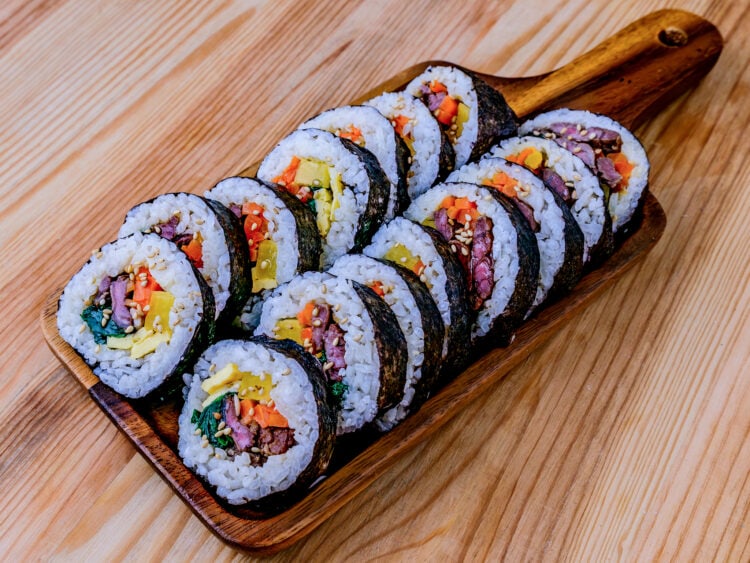A delicious, easy-to-make Korean beef Kimbap. This classic version isn’t difficult, though it does take a little time. The good news is that once the fillings are ready, you can roll out a whole batch!
Kimbap, Gimbap, Korean sushi, Korean maki… food marketing agencies can’t stop talking about it amid the rise of Korean cuisine in France. So, does the famous Kimbap deserve its hype? Yes, it’s amazing. Is it worth €15 a roll? Absolutely not. That’s why, with spring around the corner, we’re making delicious homemade Kimbap.

What is Kimbap?
Kimbap, also called gimbap, is a Korean rice roll wrapped in dried seaweed and filled with all kinds of tasty ingredients. “Gim” refers to the seaweed, while “bap” means rice.
These Korean maki rolls stand out for their captivating mix of textures and flavors.
For Koreans, Kimbap is woven into childhood memories. Whether at breakfast, on school outings, picnics, or family trips, these sushi cousins were always on the menu.
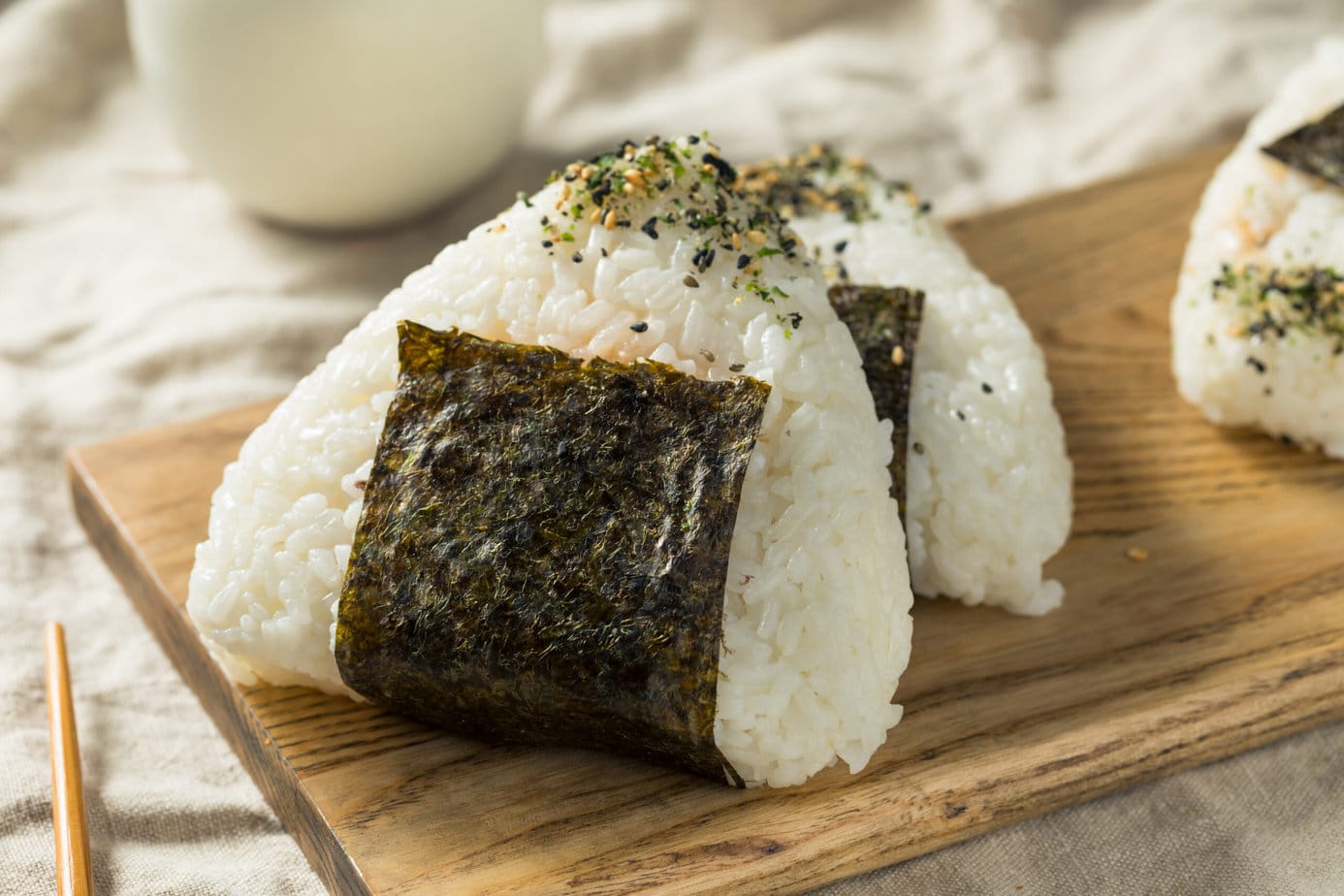
Today, Kimbap is Korea’s go-to fast meal, sold everywhere in countless varieties.
You can imagine my frustration when I see it sold as a premium dish in our restaurants… Sure, some spots put real effort into the fillings, but in many others the quality is lower than what you’d get from a Korean street stall.
Kimbap ingredients
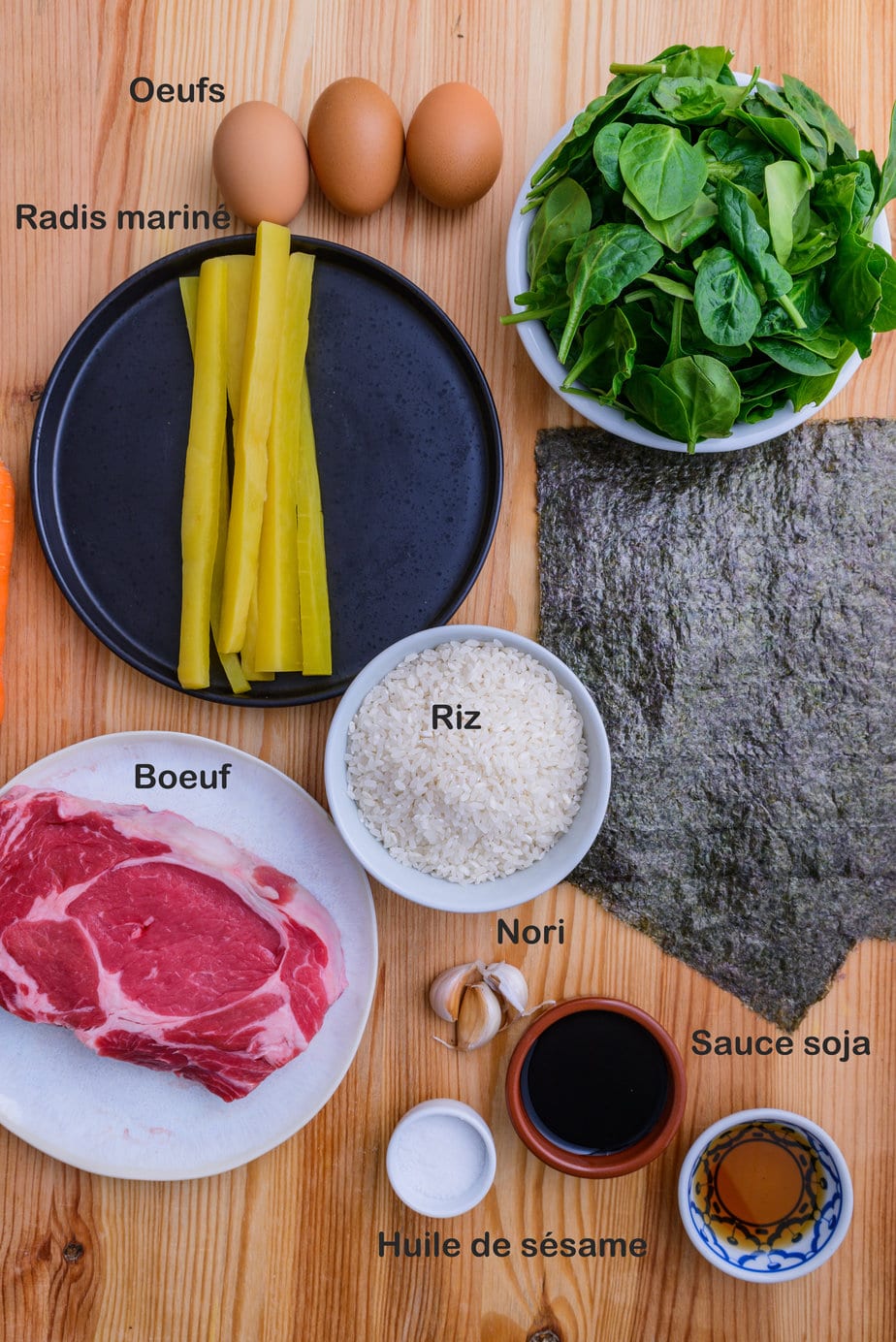
Gim 김: dried seaweed, also called nori.
Rice: short- or medium-grain rice suitable for Kimbap – in other words, sushi rice.
Danmuji 단무지: pickled radish, usually yellow, though the white version without food coloring is preferred if available.
Beef: a tender cut such as rib-eye, ideally sliced bulgogi-style (very thin).
Eggs: beat them, cook as a thin omelet, then cut into strips before adding to the Kimbap. You need to remove the chalaza.
What is the chalaza?
The chalaza is the bit of tissue inside a bird egg that anchors the yolk. It’s essentially a small white spot.

Tips for successful Kimbap
Rice for Kimbap
It’s simply sushi rice; nothing fancy. Rinse it well, and cook it slightly firmer than usual (use about 10 % less water if you’re using a rice cooker).
Pickled vegetables for Kimbap
Although prepping the fillings takes some time, the process is straightforward. Lightly season each ingredient, because everything – including the rice – is already seasoned. The pickled radish is particularly salty. In short, follow the quantities the first time and adjust for the next rolls.

Woo Young Woo’s Kimbap
The Woo Young Woo Kimbap gained popularity on social media thanks to the 2022 Netflix K-drama “Extraordinary Attorney Woo.” Woo is a brilliant lawyer on the autism spectrum. Passionate about Kimbap, she eats it at every meal, convinced of its reliability. To her, Kimbap is reassuring because it holds no surprises in texture or taste – all the ingredients are visible at a glance.

So, what’s in the Woo Young Woo Kimbap? Korean “ham” (spam), crab sticks, fish cake (eomuk), braised burdock root (ueong jorim), egg, spinach, and carrot. No beef! These ingredients are all very common in Kimbap recipes. You can easily try it at home by leaving out the beef from this recipe and adding a bit of pan-fried spam and crab sticks (surimi).
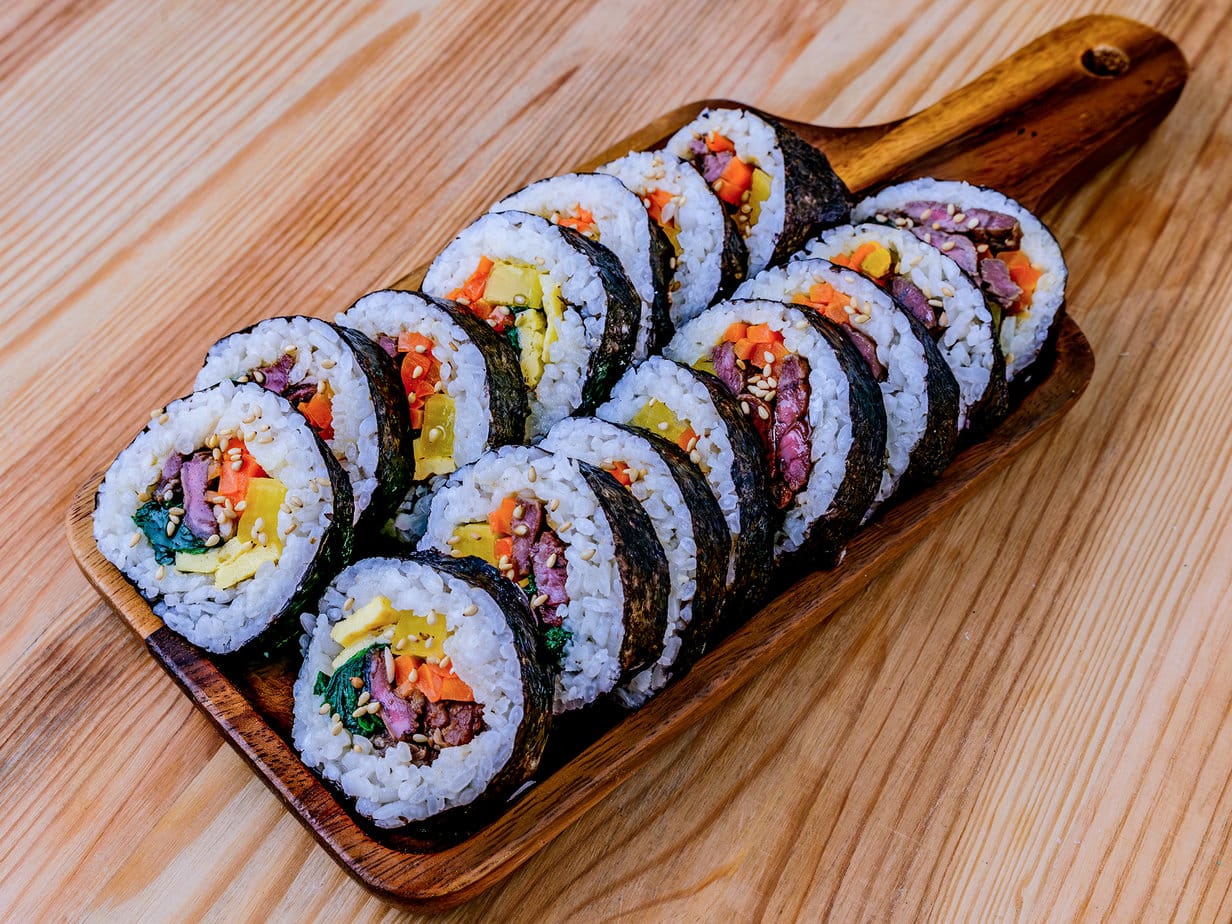
Authentic Korean Kimbap – 김밥
Ingredients
- 5 nori sheet gim in Korean
- 5 pickled yellow radish strips use pre-cut danmuji or cut into 20 cm strips
Beef
- 225 g beef
- 1 clove garlic minced
- 2 tablespoon light soy sauce
- 1.5 tablespoon sugar
- 2 teaspoon sesame oil
- vegetable oil
Spinach
- 225 g spinach blanched, rinsed in cold water, and drained
- 2 gousses garlic minced
- 0.5 teaspoon salt
- 2 teaspoon sesame oil
Carrots
- 1 large carrot cut into matchsticks
- 0.25 teaspoon salt
Rice
- 400 g sushi rice dry weight
- 0.5 teaspoon salt
- 2 teaspoon sesame oil
Egg strips
- 3 eggs
- 0.25 teaspoon salt
Instructions
Rice
- Cook the rice using your preferred method
- Put the rice in a large mixing bowl. Fold in the salt and sesame oil
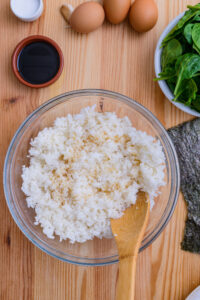
- Let it cool until it is no longer steaming. Cover and set aside.
Spinach
- Blanch the spinach
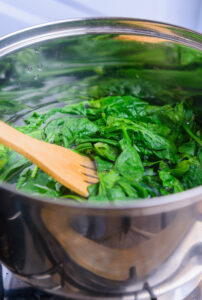
- In a bowl, combine the blanched spinach, minced garlic, salt, and sesame oil
- Mix well by hand and arrange on a large platter along with the sliced pickled yellow radish.
Carrots
- Toss the carrot matchsticks with the salt. Mix well and let them sweat for 5–10 minutes. Heat a skillet and add a few drops of oil.

- Squeeze out the excess water from the carrots, then stir-fry for about 1 minute over medium heat. Place them on the platter next to the spinach.
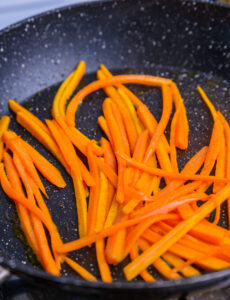
Beef
- Trim the beef and cut it into strips 0.5 cm wide and 7–12 cm long.

- Place the strips in a bowl. Add the soy sauce, garlic, black pepper, sugar, and sesame oil.
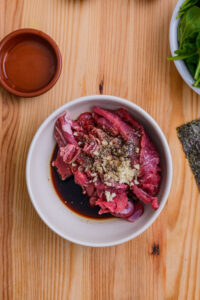
- Mix well.

- Set aside and let marinate while you prepare the egg strips.
Eggs
- Crack the eggs into a bowl and add the salt. Beat with a fork and remove the stringy chalaza*
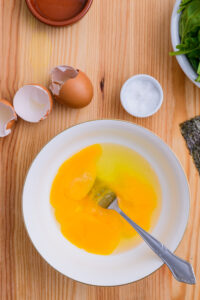
- Drizzle a few drops of oil into a heated non-stick pan. Wipe off the excess with a paper towel so only a thin film remains. Lower the heat and pour the egg mixture into the pan, spreading it into a large circle to cover the bottom.
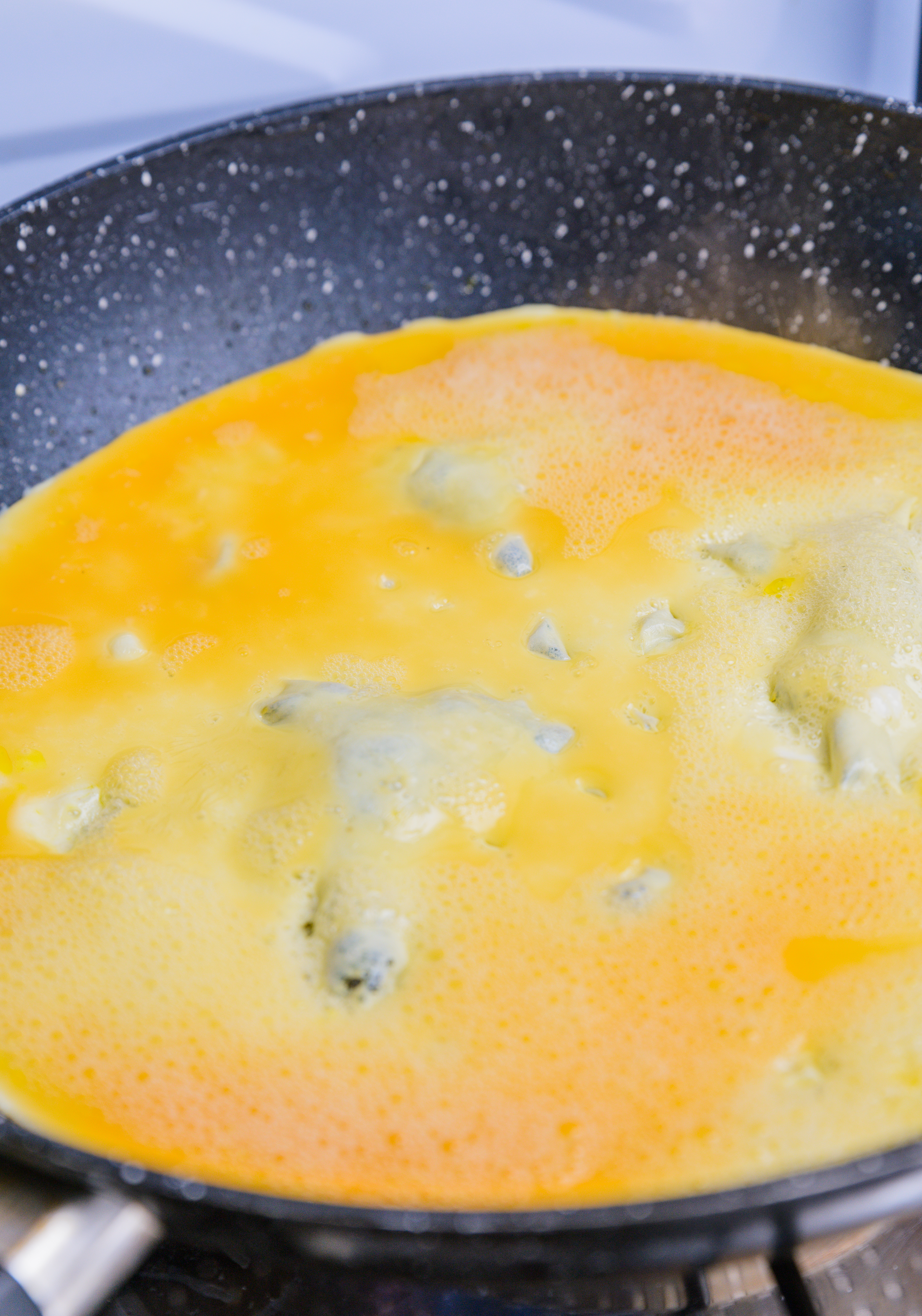
- When the underside of the egg is set, flip it with a spatula. Remove from the heat and let it finish cooking gently in the hot pan, trying to keep the egg as yellow as possible.
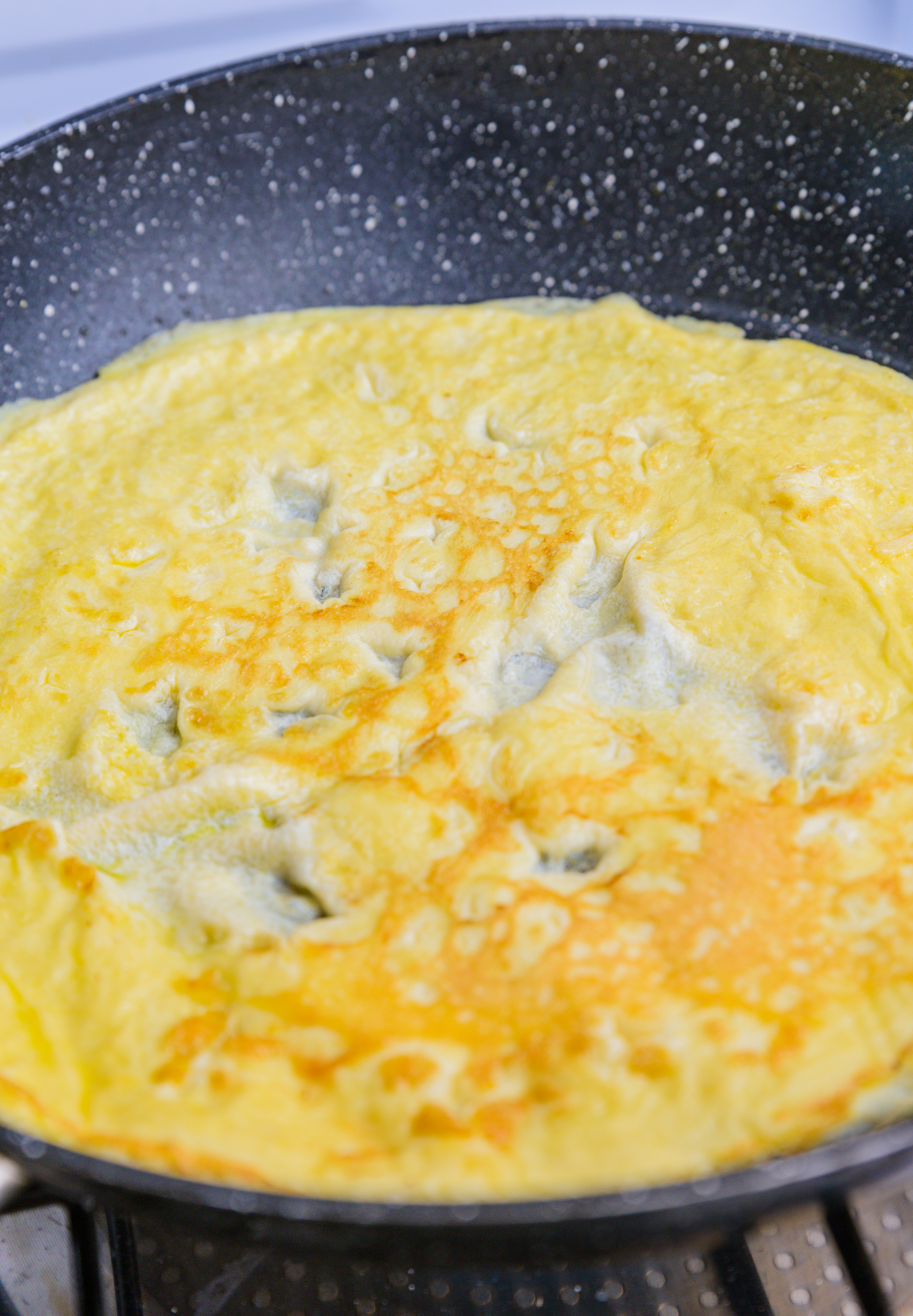
- Slice it into strips and place them on the platter next to the spinach.

Cooking the beef
- Heat a skillet over medium-high heat and cook the marinated beef, stirring with a wooden spoon until fully cooked.
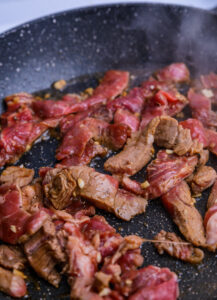
- Set aside.
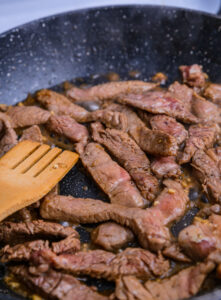
Assembling the Kimbap
- Place a sheet of nori on a bamboo mat, shiny side down. Spread cooked rice evenly over it, leaving about 5 cm uncovered on one end of the nori.
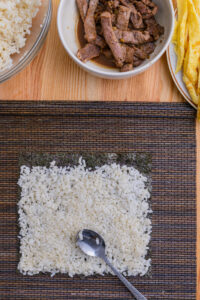
- Lay the beef, carrot, a strip of pickled yellow radish, a few egg strips, and the spinach across the center of the rice.
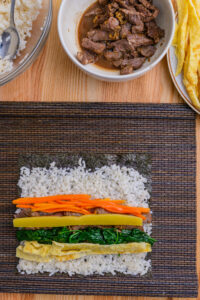
- Using both hands, roll the mat (with the nori and rice) over the filling so that one edge of the rice and gim reaches the opposite edge. This centers the filling in the roll so it will sit nicely in the middle when you cut it.
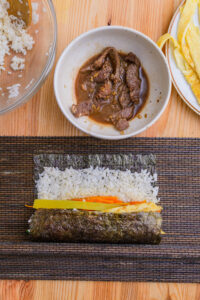
- Grab the mat with both hands and press firmly as you continue rolling the gimbap. Push the mat forward as you roll so it doesn’t get wrapped inside the gimbap.
- Remove the roll from the mat at the end and set it aside seam-side down to seal.
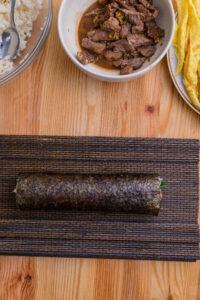
- Repeat with the remaining ingredients
- Brush the finished rolls with a little sesame oil and sprinkle sesame seeds on top.
- Slice each roll into 1–1.5 cm pieces with a sharp knife, wiping it occasionally with a damp paper towel or cloth to remove starch and make cutting easier.

Notes
Nutrition
Culinary sources
I drew inspiration for this recipe from the English-language blog Maangchi
